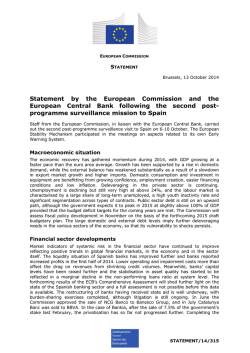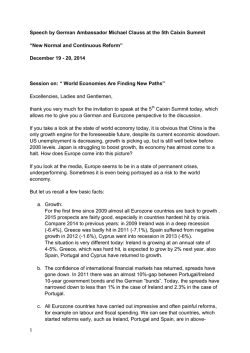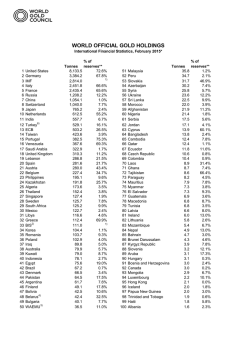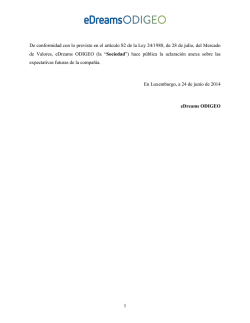
Press Release-Concluding Statement AIV PPM
Portugal: Concluding Statement of the 2015 Article IV Mission Lisbon, March 16, 2015 A Concluding Statement describes the preliminary findings of IMF staff at the end of an official staff visit (or ‘mission’), in most cases to a member country. Missions are undertaken as part of regular (usually annual) consultations under Article IV of the IMF's Articles of Agreement, in the context of a request to use IMF resources (borrow from the IMF), as part of discussions of staff monitored programs, or as part of other staff monitoring of economic developments. The authorities have consented to the publication of this statement. The views expressed in this statement are those of the IMF staff and do not necessarily represent the views of the IMF’s Executive Board. Based on the preliminary findings of this mission, staff will prepare a report that, subject to management approval, will be presented to the IMF Executive Board for discussion and decision. An International Monetary Fund (IMF) mission visited Lisbon during March 5-17 for the 2015 Article IV consultation discussions, part of the IMF’s regular surveillance of all member countries. At the end of the visit, IMF mission chief Subir Lall thanked the authorities for the candid and constructive discussions, and issued the following statement: Portugal’s economic recovery is expected to strengthen this year. Under the economic adjustment program, severe imbalances were corrected, growth was restored and unemployment began to decline. However, long-standing challenges will require sustained structural reforms. A confluence of positive external factors – a more favorable euro exchange rate, a highly supportive monetary policy environment, and low oil prices provides an excellent window of opportunity to undertake these reforms. The economic adjustment process 1. Portugal’s economic adjustment program stabilized a severely unbalanced economy. Before the sovereign debt crisis erupted in early 2011, Portugal’s consumption-based growth model led to large current account deficits. External competitiveness declined, debts rose to unsustainable levels in the private and public sectors, and growth fell well below the pace needed to converge to average EU living standards. Since 2011, with policies grounded within the framework of the adjustment program, the current account deficit has turned into a surplus, the previous run-up in private and public debts levels has been arrested, and full access to sovereign debt markets has been restored. Output began to expand again in 2013, while unemployment started to decline from historically unprecedented levels. Underscoring 2 the success of the adjustment process and reflecting the extraordinarily supportive yield environment in the euro area, Portugal has initiated early repayment of part of its IMF credit. 2. But policymakers still need to address several difficult legacies of the crisis and longstanding imbalances. First and foremost, on present policies, job creation over the next few years would be insufficient to reduce labor slack to acceptable levels, particularly among lower-skilled workers. A more rapid pace of job creation is also needed to reduce poverty and income inequality. Second, also on present policies, excessive levels of debt in a large section of the corporate sector will continue to act as a brake on investment, lock in misallocation of resources to unproductive firms, and pose a risk to financial stability. Third, fiscal consolidation needs to continue over the medium term, not only because of the legacy of high public debt, but also to signal that past fiscal policy excesses will not be repeated once the immediate crisis pressures subside. 3. Recent developments outside Portugal provide its policymakers with a window of opportunity to address these legacies. A much weaker euro and exceptionally low yields— related to the highly supportive monetary policy environment at the euro area level—as well as a sharp decline in oil prices, provide strong tailwinds for the economy. This confluence of factors provides an opportunity that should be used wisely to press ahead with the reform momentum. This means continuing and completing the task of building a more export-based economy, which this time delivers on the original promises of euro adoption. The Macroeconomic Context 4. The output recovery has so far been tepid. A recovery led by private consumption raised growth to about 1 percent in 2014. This has been associated with employment growth of 1.6 percent last year. The 2014 fiscal outturn is expected to be in line with the government’s target. However, public debt rose to 128.7 percent of GDP in 2014, reflecting in part several large one-off transactions. In 2015, growth is projected to accelerate to around 1½ percent, aided by a much more favorable external environment. In this context, annual average inflation is expected to turn positive this year. The overall fiscal deficit this year would remain, at 3.2 percent of GDP, marginally above the excessive deficit procedure target of 3 percent of GDP. 5. Over the medium term, the pace of activity and job creation is projected to be slow. Despite the strong cyclical impulse, investment is expected to remain too low to maintain the economy’s capital stock, and the working-age population will shrink due to aging. Although the skill composition of the labor force will continue to improve rapidly in line with past trends, output growth over the medium term is expected to settle at only about 1¼ percent. At this moderate pace, a significant portion of the existing labor slack would not be absorbed by job creation, especially in the lower-skilled segment of the labor market. Instead, workers would likely lose their attachment to the labor market and give up searching for jobs, or migrate to look for work in other countries. 3 Creating Jobs 6. Only faster-than-projected growth in exports and investment offers a sustainable route to job creation. Faster absorption of labor slack by creating jobs is possible if the most binding constraints on exports (low external competitiveness) and on business investment (excessive corporate leverage) are more forcefully tackled by policy makers. Higher exports would allow a sustainable increase in imports, especially of investment goods. This would generate a virtuous circle of growth and job creation, while maintaining external balance. 7. In Portugal’s case, structural reforms have to provide the main impetus to raise competitiveness. The adjustment program initiated and implemented a large number of structural reforms. This reform process, sometimes implemented despite opposition from well-entrenched lobbies and interests, also played a significant role in restoring the country’s credibility among market participants and foreign investors. The challenge for policymakers will be to build on this achievement. This should involve revisiting those reforms that have not yielded the hoped-for-results, fully implementing already initiated reforms, and addressing remaining bottlenecks through additional reforms. 8. The quality of public services and policies is critical for the competitiveness of firms and the well-being of citizens. Some public sector reforms may have to be revisited. Reforms of tax administration and health care have already yielded tangible pay-offs. But reforms aimed at improving the responsiveness of public administration to the needs of firms and increasing the payment discipline of public sector entities have paid off much less, especially at the local government level. To improve the functioning of public administration, only a deep-rooted reform of the state may be able to yield tangible results. 9. As regards the functioning of product markets, reforms that have been initiated should be fully implemented. Some measures aimed at reducing the cost of energy, the use of transport infrastructure, especially costs of port users, and the costs of professional and other services are still pending. The competition authority needs to be provided with the resources and support to be able to move more aggressively against anti-competitive practices in the sheltered sectors. Moreover, further market integration at the European level would enhance competition and improve market efficiency. While the legacy costs of past policy mistakes are difficult to fully undo in areas such as energy or road infrastructure, it will be particularly important to avoid sliding back on reforms in these areas. 10. Fresh reform ideas and initiatives should be considered in the labor area, while avoiding recourse to policies that undermine job creation. A significant effort has already been made to use active labor market policies to improve skills and labor attachment of workers. But the productivity of workers, especially the low-skilled, also depends on the skills of managers. The effectiveness and scope of programs to promote managerial skills in 4 Portugal should therefore be reviewed. Keeping long-term unemployed workers attached to the labor market will be a continuing challenge. With an increasing share of workers paid at the minimum wage, additional premature increases would further lower the chances of lower-skilled workers to make the transition from inactive or unemployed status to jobs. While minimum wages can be useful to prevent worker abuse and provide a floor to income, excessive increases can hurt the very people they are intended to help, and the government has more effective policy tools available to fight poverty. Social partners also have a special responsibility to promote job creation by supporting policies that increase the country’s competitiveness. A more inclusive and transparent social dialogue would facilitate reaching cooperative policy solutions that benefit all stakeholders. Repairing Corporate and Bank Balance Sheets 11. Excessive corporate leverage remains an important constraint to business investment. Consolidated corporate sector data indicate that the pace of corporate deleveraging has picked up in 2014, but the aggregate debt remains excessive. At the same time, it is unclear whether over-leveraged firms are at the forefront of the deleveraging process. The authorities have almost fully implemented a corporate deleveraging strategy, which includes a less favorable tax treatment of debt financing and a lowering of the threshold for creditor approval in restructuring plans. Nevertheless, these measures may not fully address the incentives that led to corporate over-borrowing in the first place, including high distributions of earnings to owners. In addition, the long-standing disincentives that prevent firm owners, creditors, and potential new investors to reach agreement to restructure debts of still viable firms may also not have been fully addressed. In particular, some banks may need more persuasion to provision for possible credit impairments. 12. More ambitious efforts by banks would mitigate the risk of getting mired in a cycle of low growth and slow deleveraging. With the banking system still facing high operational costs, overcapacity and weakening asset quality, waiting for economic growth to improve profitability could be self-defeating. Instead, banks should take advantage of the current supportive economic and financial environment to tackle the corporate debt overhang more ambitiously. They should raise more capital, increase provisioning and accelerate the pace of write-offs. This would open up space for new high quality lending, that is supportive of economic growth. It would also help lower risks to financial stability by improving the asset quality of banks. Anchoring Medium-Term Fiscal Policies 13. Medium-term fiscal policy should be aimed at reducing public debt to a more sustainable level. Fiscal consolidation achieved under the adjustment program was significant, with a structural primary adjustment of 8 percent of GDP during 2010-2014. But the consolidation effort was more heavily geared toward revenue measures than initially envisaged. Going forward, fiscal policy should be anchored around an annual structural 5 primary adjustment of 0.5 percent of GDP. This should be achieved mainly through expenditure rationalization in the context of introducing expenditure targets for each level of government. Enforcing these expenditure targets will require that specific permanent high quality policy measures are identified and implemented resolutely. Addressing public spending pressures calls for further efforts underpinned by structural reforms of the wage and pension systems. Finally, the envisaged revisions of the Budget Framework Law would be an important step in giving a medium-term orientation to public financial management.
© Copyright 2026




!["Minho - Le Nord" [no. 1 "Old Land Portugal"] - Free](http://s2.esdocs.com/store/data/000459019_1-763f6c95acdaf20bb3a9381d878beb51-250x500.png)



